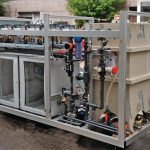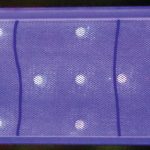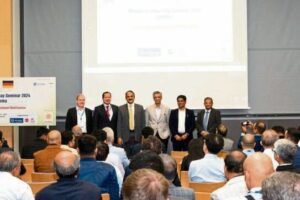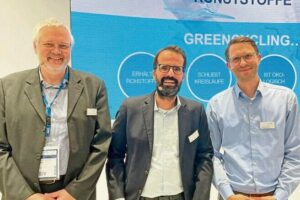Some persistent harmful substances in wastewater, such as aromatic hydrocarbons, cannot be broken down by biological wastewater treatment plants. Fraunhofer researchers have developed a photochemical reaction system in which water can be reliably treated by UV light – without having to add chemical catalysts.
Author Siegfried Egner Head of Department, Fraunhofer-Institut für Grenzflächen- und Bioverfahrenstechnik IGB
Bacteria commonly employed in the biological treatment stage have no effect on persis-tent substances, which include highly stable hydrocarbons such as aromatic compounds. Researchers at the Fraunhofer Institute for Interfacial Engineering and Biotechnology IGB in Stuttgart have now developed a reactor system together with international industrial partners that breaks down this kind of resilient and harmful molecules thoroughly and efficiently – without having to add chemicals like hydrogen peroxide or ozone, for instance.
Instead, the reactor system uses the “self-healing” power of water aided by photolysis as a chemical auxiliary. The principle of photolysis is based on splitting water molecules using photons. The shorter the wavelength of light, the higher the photon energy. The unit therefore uses light sources that emit UV light exclusively in the 172 nm wavelength range – i. e. extremely high-energy photons. As soon as these photons enter the water, they split the H2O molecules, forming highly reactive hydrox-yl radicals as a result. Hydroxyl radicals have an even higher reaction potential than atomic oxygen, for example. They are therefore able to decompose even very stable hydrocarbon compounds contained in harmful residues and thus facilitate so-called mineralisation, that is the complete degradation of the pollutant molecules down to CO2.
Micromixing is the secret
There is a catch, however. The high-energy light is absorbed by the water extremely quickly, so that this process only takes place directly at the surface of the UV emitter – a rectangular, flat glass element that is positioned in the reactor vessel. The reactive boundary layer is a maximum of 100 to 120 µm deep; a large part of the light energy is absorbed within a radius of just 35 µm. Yet the natural flow of the water is laminar – meaning that the flow direction always remains constant. If a volume element enters the reactor at a height of 200 µm, for instance, it remains in this position throughout the cycle and may possibly not pass the reactive bound-ary layer at all. In order to be sure no harmful particles escape untreated, the water in the reactor must be directed through the boundary layer in a controlled way or this boundary layer continuously exchanged – a really tricky job. On the one hand, you have to make sure the entire contents of the reactor vessel are treated. On the other, every single hydroxyl radical formed should also be used for a chemical reaction. This is because the highly reactive hydroxyl radicals are extremely short-lived. If no reaction partner is found in this time period, the energy remains unused. However, with the help of a special mixing technique the research team has been successful in controlling the movement of the water so exactly that the entire reactor vessel contents are treated reliably and highly efficiently. This so-called micromixing is based on a special geometry, where the water flow is guided by mechanical obstacles in such a way that the boundary surface is continuously mixed.
Plans for a high-throughput system
The first industrial prototype has a maximum throughput of 2.5 m3/h. A certain amount of variation is normal since the processing speed also depends, of course, on the degree of contamination. In most cases the water contains various chemicals that are broken down at different rates. Thus, the chemical reaction kinetics can hardly be predicted.
To ensure that the water is only discharged if its quality is impeccable, the unit is equipped with an additional safety mechanism. Right by the discharge port there is an online sensor system that monitors the water for remaining carbon compounds. If the impurities do not fall below the maximum permitted value, the contents of the reactor have to be directed through the boundary layer repeatedly until all residues have been broken down. The entire unit is fully automatic and programmable – and can be operated flexibly. For instance, it can be switched on and off depending on the electrical power rates on offer, enabling fluctuating, renewable electricity to be used directly.
The potential uses of this technology are found especially in process water management in the chemical and pharmaceutical industry. However, landfill leachate could also be treated utilising this technology. Against the background of high pollution levels in the North Sea, the option of a fourth purification stage in wastewater treatment plants has been debated for some time now. This fourth stage would ensure the retention of highly diluted residual pollutants by means of special membranes or adsorbers. The remaining concentrate could then be treated using the new method. In a future phase the unit will be scaled up, making it particularly attractive as a high-throughput system for industrial users that generate contaminated process water in large quantities.
cpp-net.com/0115415
Share:










